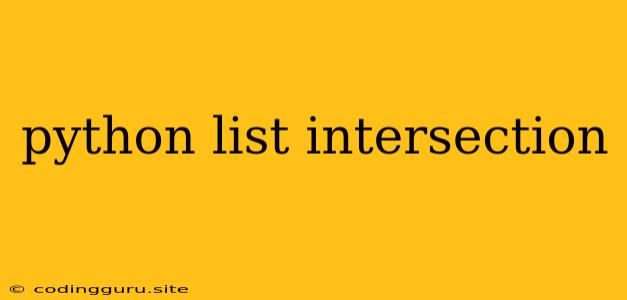Finding Common Ground: Python List Intersection
In the world of programming, lists are fundamental data structures used to store sequences of elements. Often, you'll find yourself needing to determine the common elements shared between two or more lists. This is where the concept of list intersection comes into play. Let's delve into how to find the intersection of lists in Python, along with the various techniques and considerations.
What is List Intersection?
In simple terms, list intersection refers to the process of identifying elements that are present in both of your input lists. The result is a new list containing only those shared elements.
Why is List Intersection Useful?
List intersection proves to be a valuable tool for various scenarios:
- Data Analysis: When working with datasets, you may need to identify overlapping entries between different data sources.
- Database Queries: In database operations, intersection can help refine queries by finding records that satisfy multiple conditions.
- Set Operations: List intersection mimics the intersection operation found in set theory, allowing you to perform logical comparisons between sets of elements.
- Code Optimization: It can streamline your code by efficiently finding shared elements, avoiding unnecessary iterations.
Methods for Finding List Intersection in Python
Python provides several approaches to determine the intersection of two lists. We'll explore the most common methods, highlighting their advantages and considerations:
1. Using the set() Function
This method leverages Python's built-in set() function, which effectively converts lists into sets. Sets inherently possess the ability to find intersections.
Example:
list1 = [1, 2, 3, 4, 5]
list2 = [3, 5, 7, 9]
intersection = list(set(list1) & set(list2))
print(intersection) # Output: [3, 5]
-
Explanation:
- The
set()function transformslist1andlist2into sets. - The
&operator performs set intersection, giving you a new set containing common elements. - We use
list()to convert the resulting set back into a list.
- The
-
Advantages:
- Concise and efficient: The
set()approach is quite readable and performs well, especially for larger lists. - Eliminates duplicates: Sets inherently do not allow duplicates, so the resulting intersection will only contain unique elements.
- Concise and efficient: The
-
Considerations:
- Order is lost: Sets are unordered collections, so the order of elements in the intersection may differ from the original lists.
- Only for hashable elements: The
set()function only works with elements that are hashable (e.g., numbers, strings, tuples). You cannot use it with lists or dictionaries directly.
2. Using List Comprehension
This approach allows you to construct the intersection list directly within a list comprehension, offering a more compact syntax.
Example:
list1 = [1, 2, 3, 4, 5]
list2 = [3, 5, 7, 9]
intersection = [x for x in list1 if x in list2]
print(intersection) # Output: [3, 5]
-
Explanation:
- The list comprehension iterates through each element (
x) inlist1. - The
if x in list2condition checks if the current element (x) is present inlist2. - If the condition is true, the element is included in the
intersectionlist.
- The list comprehension iterates through each element (
-
Advantages:
- Readability: The syntax is clear and concise, especially for smaller lists.
- Preserves order: List comprehension maintains the original order of elements from
list1.
-
Considerations:
- Performance: This method may be less efficient for larger lists due to the repeated lookups within
list2. - Duplicates are kept: If there are duplicate elements in
list1, they will be reflected in the intersection if they also exist inlist2.
- Performance: This method may be less efficient for larger lists due to the repeated lookups within
3. Using the intersection() Method (For Sets)
If you have already converted your lists to sets (using set()) or are working with existing sets, the intersection() method provides a direct way to find the common elements.
Example:
set1 = {1, 2, 3, 4, 5}
set2 = {3, 5, 7, 9}
intersection = set1.intersection(set2)
print(intersection) # Output: {3, 5}
-
Explanation:
- The
intersection()method takes another set as input. - It returns a new set containing only the shared elements between the two sets.
- The
-
Advantages:
- Clear intent: The method name explicitly states its purpose, making the code easy to understand.
- Efficiency: It leverages the optimized set operations within Python.
-
Considerations:
- Only for sets: This method is specifically designed for working with sets.
Conclusion
Choosing the best approach for finding list intersection depends on your specific requirements:
- Efficiency and concise syntax: Using
set()is often the most efficient and readable approach. - Order preservation: List comprehension maintains the original order but may be less performant for large lists.
- Working with sets: If you have existing sets or need to find the intersection of sets, the
intersection()method is ideal.
Understanding list intersection in Python empowers you to efficiently analyze data, refine queries, and perform logical comparisons between collections of elements.
